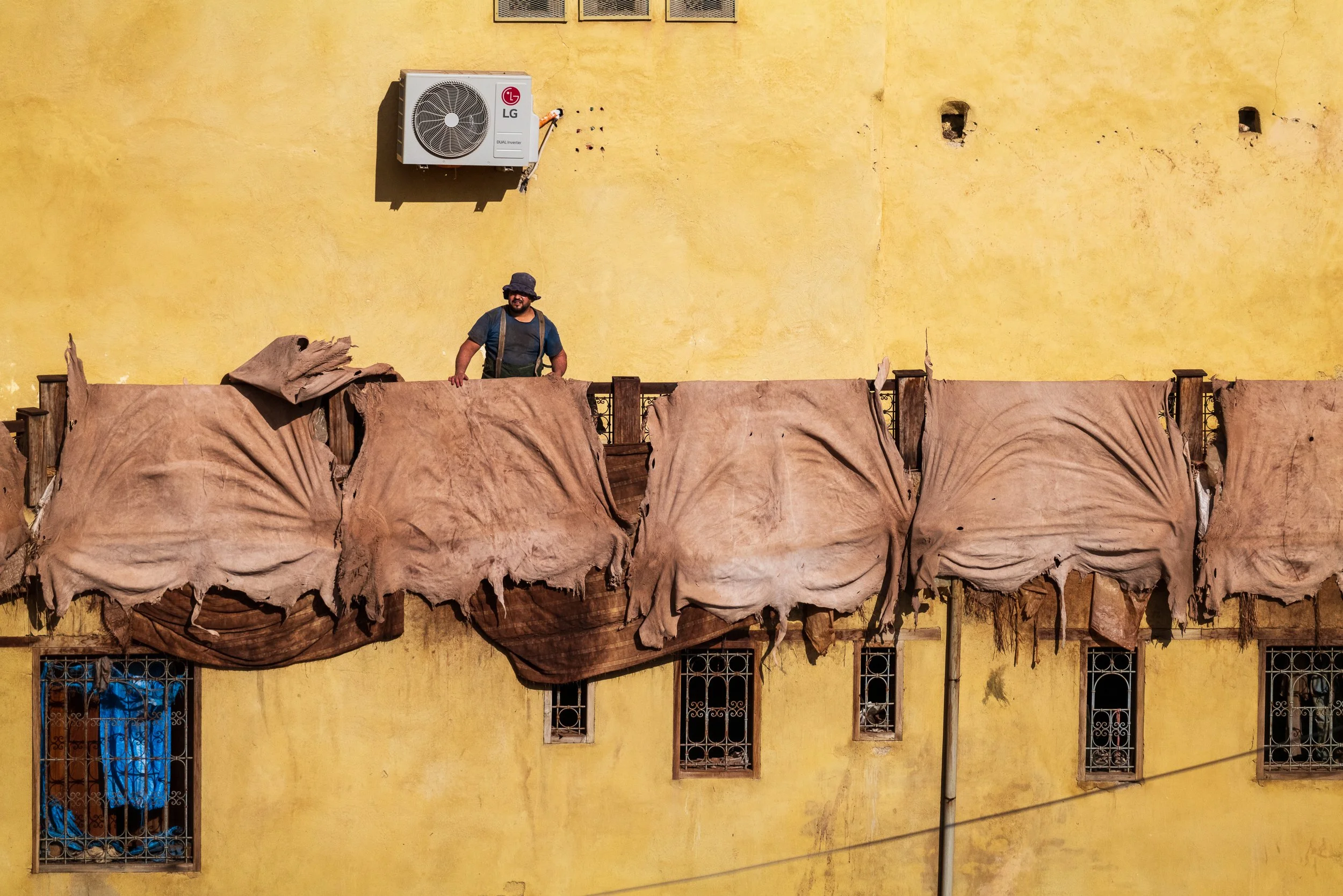DYEING FOR A LIVING
Nestled within the vibrant Fes el Bali Medina, the oldest Medina of Fes, Morocco, the Chouara Tannery stands as a living testament to the city’s rich cultural and economic history. Operating since the 11th century, this tannery is an intense sensory experience: a patchwork of brightly colored dye pits, the pungent smell of pigeon droppings, natural chemicals, and the constant rhythm of labor. But behind the artistry of Fes’ world-famous leather lies a painstaking and arduous process that tells a story of human talent and resilience but raises questions about environmental and ethical costs.
The narrow streets of the Medina are an intricate dance of wonder and chaos, each turn revealing vibrant shops, stalls, fragrant spices, tasty delicacies, and an endless stream of humanity. Navigating this labyrinth was both mesmerizing and disorienting, a constant tug-of-war between marveling at my surroundings and staying focused on my destination: the Chouara Tannery, the beating heart of Fes’ centuries-old leather trade.
As I walked, shopkeepers beckoned me from every angle, their voices blending into a symphony of offers and entreaties. Some were persistent, others charming, all with the singular goal of selling their wares or offering a tour for pay. Politely declining while maintaining my course was an art in itself.
Finally, the tannery door, down a narrow alleyway came into view - and the overwhelming smell of ammonia and flesh washed over the air. A man at the entrance handed me a sprig of mint, a gesture as practical as it was symbolic. “You’ll need it,” he said with a knowing smile. As we descended deeper into the cavernous work area, the stone floor became slicker and the air thicker. The pungent aroma of the tanning pits—a mix of animal hides, natural dyes, and age-old processes—assaulted my senses as I stepped inside.
The sight before me, and the scale of the operation was nothing short of mesmerizing: rows upon rows of sunken pits, each filled with vivid hues of red, yellow, and blue. Artisans moved methodically, their hands and feet stained by the very craft that defines this place. It was a world both beautiful and raw, where tradition and toil intersected in every step.
Preparing the Hides
The tanning process begins with raw animal hides—primarily from cows, sheep, camel and goats—arriving at the tannery. Workers soak these hides in vats filled with a mixture of water and lime to loosen hair and flesh. This step requires intense manual labor, as the hides are scrubbed clean using sharp tools. The lime mixture is highly caustic, often causing skin irritation and burns. Despite these risks, workers continue without modern protective gear, or even just gloves, relying on their expertise to gauge their tolerance level.










Softening in Pigeon Dung
Once stripped of hair, the hides are softened in vats of pigeon dung mixed with water. This natural ammonia solution breaks down the remaining fibers, making the leather more pliable. Workers wade into these vats barefoot, kneading the hides by hand or foot to achieve the desired texture. The smell in this stage is particularly overpowering, definitely nauseating, and prolonged exposure surely takes a toll on worker’s health. Yet, their endurance transforms what seems unbearable into a craft that has stood the test of time. Despite all the difficulties, many workers express pride in their role of preserving a centuries-old craft that’s integral to Fes’ identity.
Dyeing the Leather
After the hides are softened, they move to the iconic dye pits that form the heart of Chouara Tannery. Filled with vibrant, natural dyes made from materials like saffron, poppy, and indigo, these pits offer a visual feast to onlookers above. Workers immerse the hides into the colorful vats, ensuring the dye penetrates evenly. This step is physically taxing, requiring repetitive movement and prolonged exposure to dyes that can stain the skin for days. Under the intense Moroccan sun, the conditions become even more grueling. All the while, visitor’s can marvel from terraces of gift shops perched above.
Drying and Finishing
The final step involves laying the dyed hides out to dry on rooftops and open courtyards. From the upper terraces’ vantage points, the tannery’s beauty was undeniable—a stark contrast to the grueling work that made it possible. The drying process is critical, as it ensures the leather’s quality and durability. Workers then trim, polish, and prepare the leather for crafting into goods like bags, belts, and slippers. While this stage may seem less physically demanding, it requires sharp attention to detail to meet the high standards of local artisans and international markets.
Reflections on Craft, Cost, and Responsibility
Upon leaving the tannery, I carried more than just a subtle migraine, the lingering smell of lime, ammonia and dyes; I carried the weight of what I had seen. The Chouara Tannery is a place of extraordinary beauty and craftsmanship, but it is also a place of immense hardship. The workers I saw were the beating heart of this craft, their resilience and skill sustaining a craft that has shaped Fes for centuries.
Still, the tannery is also refined me of the cost behind the leather goods we often take for granted. The environmental impact, the health risks, the meager wages—these realities are hidden beneath the sheen of luxury handbags, shoes and jackets.
Workers and locals around the tannery frequently discuss the economic challenges of tannery work. Wages are typically low, and the income is often insufficient to support a family. Yet, for many, it’s one of the few viable job options in the region.
As consumers, we all have a responsibility to think critically about the origins of what we buy and the brands we support. Supporting brands that prioritize fair wages, ethical practices, and sustainability can help create a more equitable system.
It’s a small step I know, but one that honors the lives and labor behind the craft.

































